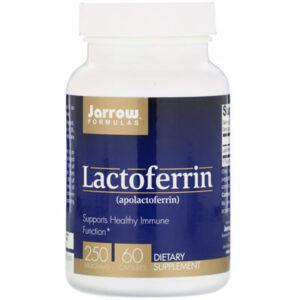Lactoferrin has been shown to be related to various physiological and protective functions in recent years, including regulating the absorption of iron in the intestine, antioxidant, anti-cancer, anti-inflammatory and antibacterial activities are currently the most widely studied functions
What are lactoferrin’s benefits and side effects?
Table of Contents
- What is lactoferrin?
- What are the benefits of lactoferrin?
- Are there any side effects of lactoferrin?
- Safety precautions
- Where to buy the most recommended lactoferrin?
What is lactoferrin?
Lactoferrin, or lactoferrin, is a glycoprotein in the transferrin family with a molecular weight of approximately 78 kDa (kilodalton) and 691 amino acids.
It was first identified as hemoglobin in whey in 1939. It was isolated and purified from human and bovine milk in 1960, confirming that it is the main iron-binding protein in milk.
Lactoferrin is produced and released by mucosal epithelial cells and neutrophils of various mammals (including humans, cows, goats, horses, dogs, and some rodents), and is present in most exocrine secretions. This includes milk, tears, saliva, intestinal mucus, and genital secretions, as well as specific granules of neutrophils.
What are the benefits of lactoferrin?
1. Lactoferrin prevents necrotizing enterocolitis
Necrotizing enterocolitis is an inflammatory bowel disease, mainly seen in premature babies, risk factors include premature birth, abnormal microbial colonization, and inadequate breastfeeding.
It is characterized by a variety of intestinal injuries, from mucosal injury to full-thickness necrosis and perforation. The clinical manifestations are non-specific, and the possible symptoms are feeding intolerance, intestinal obstruction, abdominal distension, blood in the stool, drowsiness, apnea, metabolic Acidosis, shock, disseminated intravascular coagulation dysfunction, sepsis, etc.
A systematic literature review and meta-analysis (including 9 randomized controlled trials, a total of 1834 preterm infants) pointed out that prophylactic lactoferrin supplementation can significantly reduce late-onset sepsis and late-onset sepsis. The incidence of necrotizing enterocolitis can also reduce the time of nosocomial infection, infection-related death, enter enteral feeding, and hospitalization time.
*Conclusion: For preterm infants, the use of lactoferrin may help reduce some infections.
2. Lactoferrin improves iron deficiency anemia
Nutritional iron deficiency is the most common nutritional disorder in the world, affecting more than 2 billion people worldwide, and pregnant women are particularly dangerous.
In industrialized countries, the prevalence of nutritional iron deficiency among pregnant women averages 14%, and in developing countries, the average prevalence is 56%.
In fact, even mild or moderate iron-deficiency anemia during pregnancy may be associated with adverse outcomes at birth, including premature birth, excessive birth weight, mild fetal growth retardation, and fetal death.
A meta-analysis of literature (including 4 randomized controlled trials, a total of 600 pregnant women with iron deficiency anemia) pointed out that for pregnant women with iron deficiency anemia, daily oral bovine lactoferrin can improve hematological parameters (hemoglobin level) As good as ferrous sulfate, but with fewer gastrointestinal side effects.
*Conclusion: For pregnant women with iron deficiency anemia, oral lactoferrin can help improve hemoglobin levels, and the side effects are lower than iron supplements.
3. Lactoferrin is beneficial for Helicobacter pylori eradication treatment
Helicobacter pylori is a gram-negative spiral bacteria, it is considered to be the most common bacterial infection in the world.
The site of infection is usually on the surface of the gastric epithelium and is thought to be associated with an increased risk of chronic gastritis, peptic ulcer, gastric mucosa-associated lymphoid tissue lymphoma, and gastric adenocarcinoma.
In recent years, the most popular solution to eradicate H. pylori infection is triple therapy, which includes proton pump inhibitor, amoxicillin, and clarithromycin.
However, due to the emergence of antibiotic resistance, the efficacy of these combination therapies is declining.
A meta-analysis of literature (including 9 randomized controlled trials, a total of 1343 participants) pointed out that in addition to Helicobacter pylori eradication treatment, the use of lactoferrin can increase the eradication rate and reduce the side effects of drugs.
*Conclusion: For patients undergoing regular Helicobacter pylori eradication treatment, additional use of lactoferrin may increase the eradication rate.
4. Lactoferrin regulates psychological stress
Stress is defined as a process in which the needs of the environment put pressure on the organism’s ability to adapt, which leads to an increase in psychological needs and disease risk, which have a great impact on mood, happiness, behavior, and health.
Not all stress has a negative impact. When the body is under stress and uses it to overcome burnout or improve performance, stress is positive, healthy, and challenging.
When stress exceeds our ability to cope, exhausting the body system, and causing behavioral or physical problems, stress is negative.
A double-blind placebo-controlled trial (targeted at 18 healthy female college students) pointed out that oral lactoferrin helps to regulate autonomic activity compared to placebo (heart rate variability measurement shows parasympathetic upregulation and sympathetic nerve Activity down).
*Conclusion: Oral lactoferrin has a positive effect on autonomic regulation and may help to reduce the psychological response under stress.
5. Lactoferrin is beneficial for acne improvement
Acne, also known as acne, is a multifactorial chronic inflammatory disease of the hair follicle sebaceous unit and is one of the most common skin diseases, mainly affecting teenagers, although it may appear at any age.
Various clinical manifestations include seborrheic, acne, erythematous papules, and pustules, nodules, deep pustules or pseudocysts are rare and may cause scarring and pigment changes.
The pathogenesis of acne is multifaceted, including abnormal hair follicle keratinization, increased androgen leading to increased sebum production, proliferation, and inflammation of Propionibacterium.
A randomized, double-blind, placebo-controlled trial (a three-month, 168 patients with mild to moderate acne) pointed out that oral lactoferrin, vitamin E, and zinc combination can improve the overall number of lesions, acne inflammatory lesions And other indicators such as sebum fraction.
*Conclusion: For patients with mild to moderate acne, oral lactoferrin compound may bring positive help to improve the condition.
Are there any side effects of lactoferrin?
It is safe to take lactoferrin in moderation, but the side effects that have been reported are diarrhea, rash, dizziness, headache, loss of appetite, fatigue, chills, and constipation, especially in high-dose use.
Safety Precautions
If the blood iron content is higher than normal, avoid taking it to prevent excessive iron in the blood.
For those with poor liver and kidney function, pregnancy, lactation, children under the age of 18, taking medicines, etc., if you want to use lactoferrin supplements, it is best to consult a medical professional.
Where to buy the most recommended lactoferrin?
In recent years, food safety problems in various countries have exploded, and it is not healthy but black-hearted products that everyone spends on. Therefore, European and American products with relatively strict quality control have become popular products.
And iHerb.com is a large-scale medical cosmetics e-commerce company in the United States. It has a high satisfaction rate of 97% in the evaluation of Google customers. It provides global home delivery so that you can buy it without risking buying fakes through purchasing high-quality health products.

